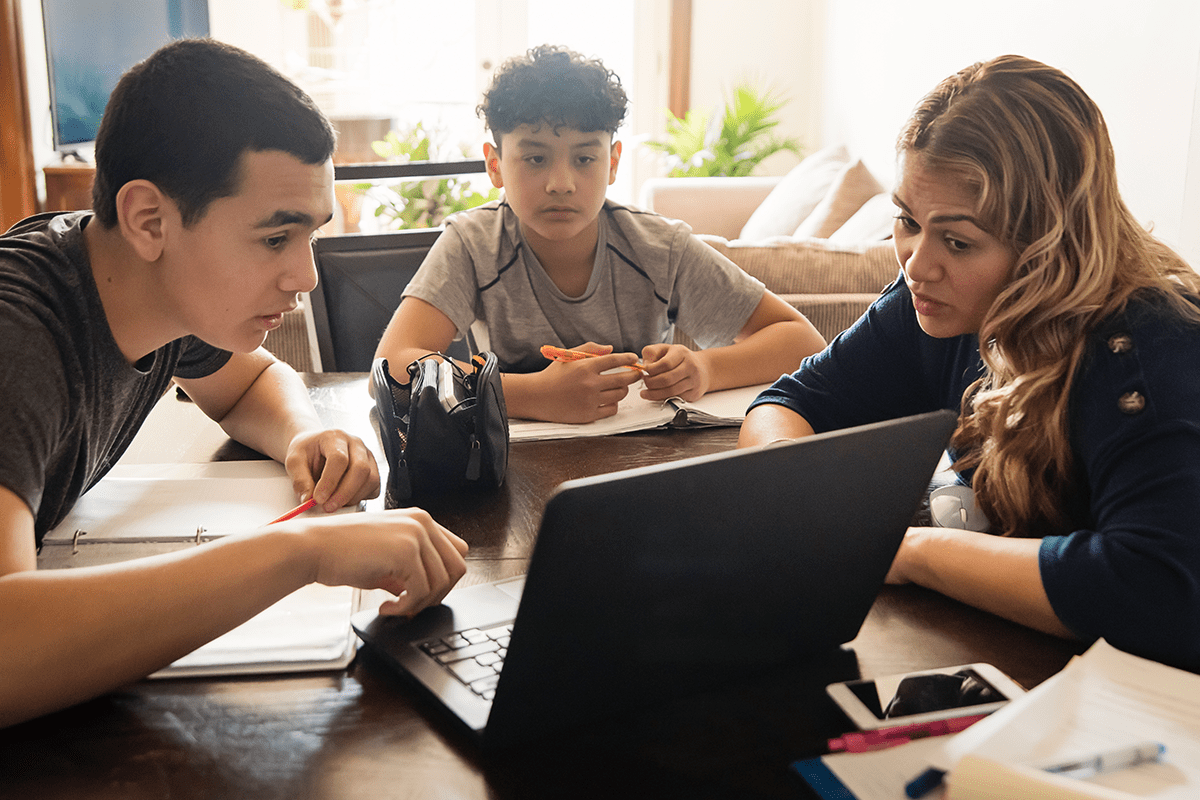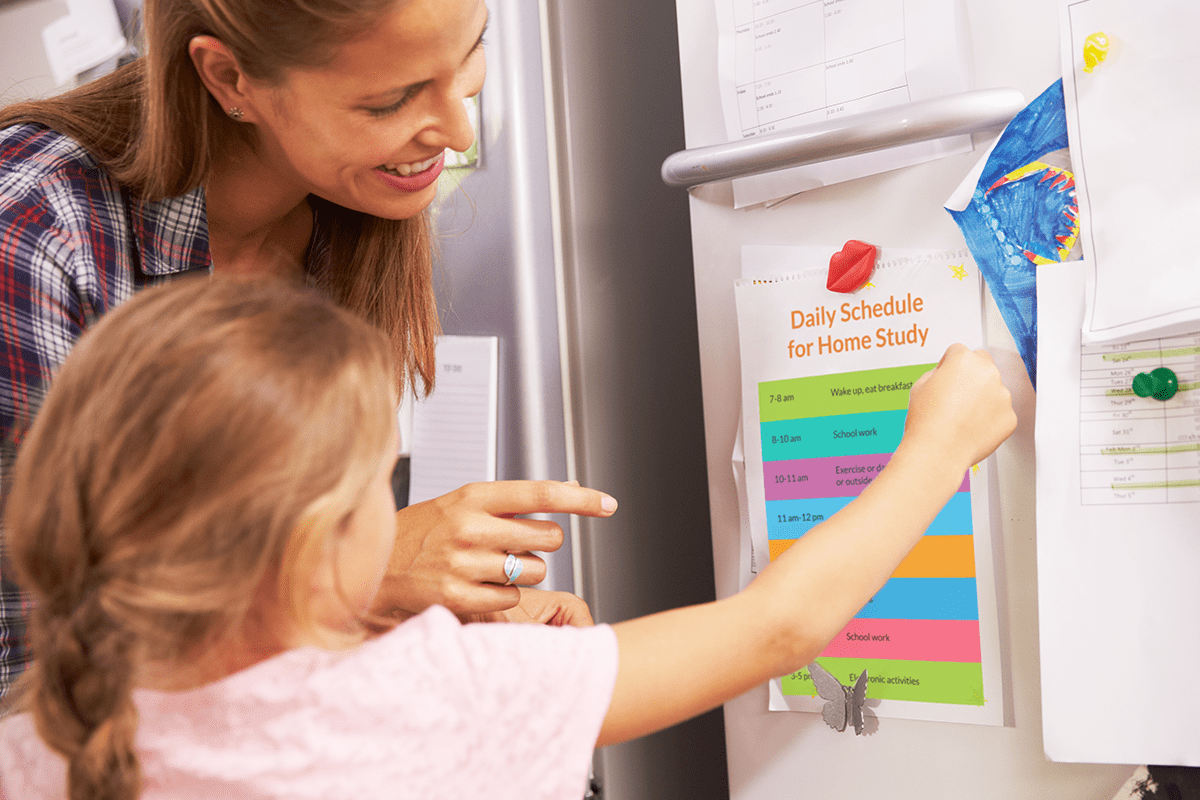Hold a Family Meeting
First, hold a family meeting to establish your particular shared values. In an educational context, a family meeting is an intentional conversation among the members of a family unit to discuss shared values so that everyone is set up for productive and successful days. Here are some questions to answer in the meeting:
- What does each member of the family need to focus on?
- Does anything in our current family schedule need to change right away?
- Are there specific times of day that are sacred work times for the adults or the children?
Many parents are trying to accomplish their own work projects while simultaneously facilitating learning for their children. This may seem like a near-impossible task, but little tweaks to your communication and scheduling can help.
Classroom teachers begin their school year with conversations about norms and expectations. It will be helpful for your family to do the same. The ages and abilities of your children will dictate the direction of this conversation. A family with multiple young children at home may have a simple, short conversation and decide that a couple of their shared family values are “we share toys during free play” and “we stay in our room during afternoon quiet time.” A family with both partners working full-time and older children in the home may find their shared values revolving more around respecting one another by limiting interruptions during set work and study hours.
The point is to have the initial conversation in a context that makes sense for your family. Post these shared values with words and/or pictures so everyone can easily reference them.

Routine, Routine, Routine
After you’ve set your family values, make a schedule. Think through your new routines and write out the general timeline for what will happen each school day. You may need to make one schedule for the adults and a more accessible visual schedule for your child. Visual schedule templates are online (many created by teachers), or if you have access to SymbolStix PRIME, you can easily create and print a visual schedule. Post this where your child will see it regularly.
Children thrive on routine. This is especially true for children with learning differences or behavioral challenges. Routines help children feel confident, safe and secure because they know what to expect and when things will happen. They understand their role in the activity or task at hand. Your child’s routine has certainly shifted with the onset of this worldwide pandemic. But, children are resilient and can adapt to new routines with practice and consistency. A daily family schedule will help create a new rhythm for your child. It will help you all take a deep breath in and continue moving toward your goals.
It’s helpful if your typical morning routine (wake up, get dressed, eat breakfast, etc.) can stay the same or be very similar. Next, make a plan for the different components of your child’s day, such as:
- Academic time
- Outside play/physical activity
- Nap or quiet time
- Chores
- Screen time
- Snack and meal times
Remember, the family schedule for a stay-at-home-parent of a kindergartener and second grader with a newborn baby sister will look quite different from the routines of two parents working remotely full-time with one high-school student who is fairly self-sufficient. That’s OK! Think about what will work best for your family and be willing to adjust as you go if something isn’t working well.

Place
You already know that your child does well with a designated place to complete their homework. Remember, children thrive on routines and consistency. Your child’s need for a specific study spot will continue to exist throughout this period of remote learning. Maybe their work space can be at a desk in their bedroom or at the family computer in the living room. Determine a place that will serve as a homebase for all school things—tablet, binders, textbooks and all supplies.
Learning will certainly not be confined to this one place, but having a designated spot will help everyone stay organized. After your math lesson in the kitchen or your nature walk in the back yard, regroup and reinforce the learning objective with an essay, video or short story in the school spot.
Accommodations and Sensory Supports
Take a moment to review the most recent copy of your child’s IEP. What accommodations are listed? Is a calculator allowed for all math work, or are opportunities for frequent breaks provided? Remember that these accommodations will help your child be available for learning at home and successful, too.
If your child’s teacher regularly offers sensory supports such as flexible seating, fidget toys, stress balls or noise-cancelling headphones, try to provide similar sensory supports at home. Don’t worry if you don’t have an advanced degree in curriculum and instruction! You know your child best, and with practice, communication and patience, you and your child will get the hang of remote learning.

Be Flexible
No classroom schedule is written in stone. Similarly, your family’s rhythms are bound to need tweaks (or overhauls!) at some point in the coming weeks or months. Your work schedule may change, you or your child may have an appointment or your child may be ready for more—or less—academic work than you initially thought. The point is to establish a learning environment in your home that includes agreed-upon family values to support one another, a consistent schedule, a place for school work and appropriate accommodations.
Taking the time to establish the learning environment will go a long way for the weeks and possibly months of distance learning ahead. It will help shape your days at home with your child while they learn and play to bring confidence and stability for the whole family.
Take a deep breath—you’ve got this!
